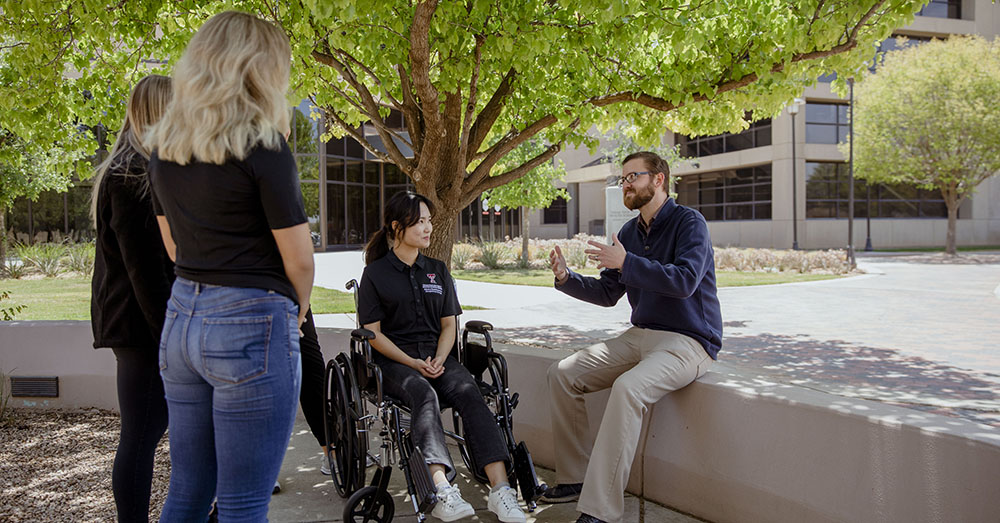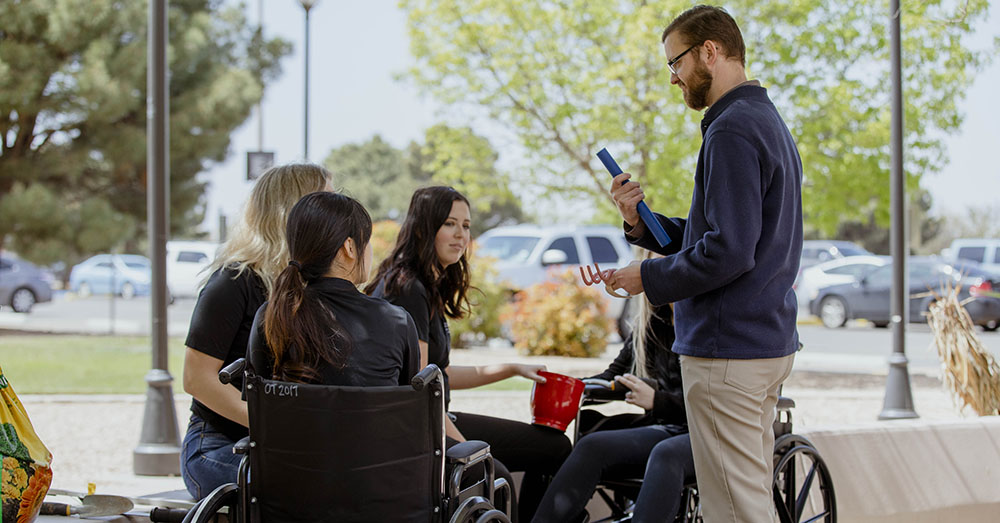Ergonomics: A Critical Piece of Occupational Therapy Education
Why should we care about ergonomics in the workplace?

When we hear the word “ergonomics,” many of us merely think of office chairs and good posture, and that’s as far as our understanding goes. But there is much more to ergonomics than just your desk chair.
We spoke with Robert Larson, OTR, PhD, Assistant Professor in the Doctor of Occupational Therapy Program of the Rehabilitation Sciences Department in the TTUHSC School of Health Professions, about the origins of ergonomics and its importance in occupational therapy.
Ergonomics is basically any adjustment to “help you be in a good position to be able to complete your work throughout the day,” Larson begins.
“In general, we’re looking at ways to reduce stress on the human body,” Larson explains. “That’s important in office chairs, because if you have a poorly designed chair that you’re using for 40 years, you have undue stress on your body.”
Ergonomics also covers where your computer monitor is placed and at what height. Furthermore, the keyboard and mouse you use can be evaluated and changed using ergonomics.
The principles of ergonomics extend beyond office work to laborers who are lifting objects on a regular basis.
“There are appropriate ways to lift things, move and slide things,” Larson says. This applies to any area of life, not just specific occupations. “Is your work surface the right height for the task you’re doing?” Larson asks.
Ergonomics for Healthcare Workers
Larson points out that in the healthcare field, nurses and CNAs have been among the most physically injured workers in the country for many years.
“There are efforts to reduce the amount of unnecessary force on healthcare workers’ bodies by using friction-reducing devices and mechanical lifts, instead of manual patient handling,” he says. “That’s been getting more traction recently, and it’s been a long time coming.”
Larson states that there have been positive results but there is still a lot of work to do for our vital healthcare workers.
Ergonomics as Part of Occupational Therapy Training

Larson explains that ergonomics is part of most curricula in most Occupational Therapy programs, especially when it comes to patient handling. The National Institute for Occupational Safety and Health (NIOSH) has a guideline that advises healthcare workers not to lift more than 35 pounds when handling patients. Larson explains that students are given the opportunity to work with devices designed to aid in patient handling.
“We spend time troubleshooting strategies to keep the spine in a neutral position when doing patient-handling tasks,” he says. “We talk about asking for help when you need it.”
Larson believes that any good healthcare facility should promote this principle of asking for help when needed.
“We as educators advocate for that as well,” he says. “Know your limits. Know what the recommended limits are and do your best to stay within those guidelines.”
Ergonomics and the Law
We ask Larson what a company’s legal responsibilities are when it comes to ergonomics.
“Depending on the state, there are patient handling laws,” he answers. “However, they are not enforced.” Larson says there are laws that are not being followed through on.
“The responsibility of the facilities who employ healthcare workers should be to know the laws and have the appropriate equipment available, so healthcare workers can do best practice,” he says. “A lot of times, it’s not a possibility and it can be a fight with facilities to be able to get the materials necessary for appropriate patient handling. That’s a problem.”
He continues that the overall percentage of musculoskeletal injuries for healthcare workers is trending down, but it still remains among the highest in the country.
“Best practice is to have training and requirements,” he says regarding healthcare workers. “Require employees to utilize the supplies and best practices.”
He explains that some facilities successfully use a rewards system for staff who are using best practices in patient handling.
Sitting is the New Smoking
“Sitting is the new smoking,” Larson warns.
Sitting for long periods of time comes with detrimental effects on your health.
“When you sit all day in the same position, that’s really damaging your back,” Larson begins. “Because you have a constant pressure on parts of the spine, it inhibits recovery of those structures.”
He also reminds us that a lack of physical activity is damaging in the long run, referencing historical occupations for perspective.
“Farmers were outside all day long doing manual labor,” he says. Sitting for long periods of time can be hazardous for your health.
Setting Up an Ergonomic Desk
Larson cites guidelines for setting up your desk:
- The top of your computer monitor should be at eye level.
- Your monitor should be directly in front of your face and not to the side, for the sake of your neck and shoulders.
- Your hips, knees and ankles should be at 90 degrees.
- Arm rests should be set an inch above where the arms naturally fall when resting.
- Head and neck support is a great addition to a desk chair.
However, these recommendations come with a caveat.
“When you get uncomfortable in that position, you need to change positions,” he advises. He recommends listening to your body and taking breaks and changing positions regularly.
He also recommends giving a standing desk a try.
Related Stories
TTUHSC School of Nursing Celebrates 10 Years of the Veteran to BSN Program
The TTUHSC School of Nursing recognized the 10-year anniversary of the Veteran to Bachelor of Science in Nursing (VBSN) program during the fall 2025 commencement ceremonies held Dec. 13 in Lubbock, Texas.
Lubbock ISD Middle School Students Become Docs for a Day
Lubbock Independent School District students from Atkins Middle School, McCool Academy and Evans Middle School became doctors for a day as the TTUHSC Student National Medical Association (SNMA) hosted Docs for a Day Nov. 10.
From Classroom to Clinic: Building the Future of Speech-Language Pathology
The Clinical Experience Course in the Speech, Language and Hearing Sciences program at TTUHSC provides students with hands-on, practical application of the theoretical knowledge learned in the classroom.
Recent Stories
Making Mental Health a Priority in the New Year
Sarah Mallard Wakefield, M.D., a psychiatrist with Texas Tech Physicians, talks about strategies to combat widespread and growing anxiety.
TTUHSC Cancer Researcher Honored by National Academy of Inventors
C. Patrick Reynolds, M.D., Ph.D., director of the School of Medicine Pediatric Cancer Research Center at TTUHSC, has dedicated his life as a researcher to developing treatments for childhood cancers.
TTUHSC School of Nursing Celebrates 10 Years of the Veteran to BSN Program
The TTUHSC School of Nursing recognized the 10-year anniversary of the Veteran to Bachelor of Science in Nursing (VBSN) program during the fall 2025 commencement ceremonies held Dec. 13 in Lubbock, Texas.
